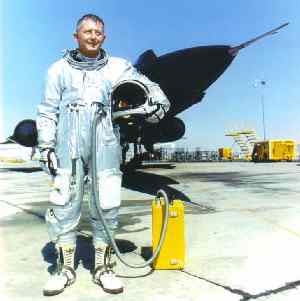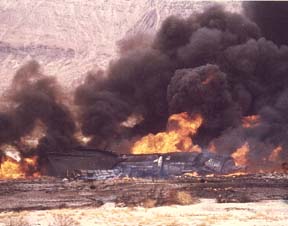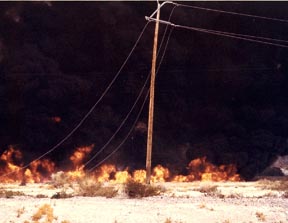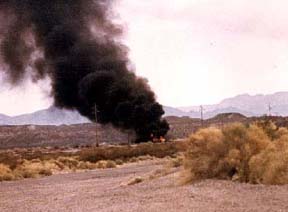The Crash of SR-71 #95318 December 1969Speed Equals Stealth...  | Colonel Joseph Rogers, in a pressure suit and in front of an SR-71 "Blackbird" |
The SR-71 "Blackbird" was designed & developed in secrecy by the Lockheed "Skunk Works" by a team headed by Clarence L. "Kelly" Johnson. First built as a Mach 3 interceptor for defense against supersonic bombers (the A-12 and YF-12), it was find to be unsuited to the task, but much better as a supersonic high-altitude photographic reconnaissance platform. Fueled by JP-7, and powered by two Pratt & Whitney J58 Turbojet Engines, the Blackbirds were capable of cruising at Mach 3.2 and attaining altitudes in excess of 80,000 feet. The Dryden Flight Research Center's involvement with the YF-12A began in 1967. Ames Research Center in Sunnyvale, California, was interested in using wind tunnel data that had been generated at Ames under extreme secrecy. Also, the Office of Advanced Research and Technology (OART) saw the YF-12A as a means to advance high-speed technology, which would help in designing the Supersonic Transport (SST) that Boeing was designing, and the Air Force needed technical assistance to get the latest reconnaissance version of the A-12 family, the SR-71A, fully operational. Eventually, the Air Force offered NASA the use of two YF-12A aircraft, 60-6935 and 60-6936. A joint NASA-USAF program was mapped out in June 1969. NASA and Air Force technicians spent three months readying #953 for flight, which first flew in June of 1965. On 11 December 1969, the flight program got underway with a successful maiden flight piloted by Colonel Joe Rogers (Holder of the world record for flying the fastest single-engine jet) and Major Gary Heidelbaugh of the SR-71/F-12 Test Force. A Routine Test Flight... After some modification were made to SR-71 #953's Electronic Counter-Measures (ECM) systems, and the installation of the new ITEK "Optical Bar Camera", used for taking panoramic photographs, in the nose of the plane, the aircraft was tasked with a test flight to insure the ECM's proper function, in what is known as an functional check flight (FCF), and assigned the mission callsign of "Dutch 68". According to Bill Campbell, Rogers’ Wing Operations Officer and safety chase plane pilot on the flight, after conducting the normal FCF items at 15,000 feet, the aircraft was scheduled to refuel on the Beatty Track and then proceed on a Mach 3+ cruise profile to test the new sensor. Once completed, #953 was scheduled to return to Edwards. Campbell was in an F-104 during the early portion of the mission until the FCF items had been completed. When "Dutch 68" headed for the tanker, Campbell returned to Edwards to change into another F-104 and act again as safety chase when the SR-71 returned to the Edwards area. Campbell described the weather on December 18th as what pilots call "VFR", meaning a good flight visibility and cloud ceiling allowing for a good separation from other aircraft traffic. However, the visibility at 15,000 feet and above was limited enough that the horizon was obscured. In order to maintain level flight, the pilot had to closely monitor the altimeter and rate of climb instruments. The majority of the items conducted during the FCF portion were completed at a planned altitude of 15,000 feet. But Campbell noticed that Rogers was flying a slowly wandering altitude profile between 13,500 and 16,000 feet. Knowing that Joe was a very skilled pilot, and had over 200 hours in “Blackbirds”, Bill did not call out this anomaly. He thought Joe was more intent on the FCF items than maintaining a tight control on altitude. After all, the pair of aircraft were flying VFR and maintaining their own traffic separation. After completing the FCF items, Joe requested an Instrument Flight Rules (IFR) clearance and a new altitude of Flight Level 250 to meet his tanker. A normal rendezvous and in-flight air refueling were completed at a "Block Altitude" of 25,000 to 27,000 feet. When Rogers dropped off the tanker with full tanks at FL 260, he descended to the bottom of the block at FL 250 and requested clearance to climb to above FL600 (60,000 feet). Expecting the Unexpected... When the Air Traffic Control facility, Los Angeles Center, approved that request, Rogers moved the throttles to 'Afterburning' and planned to start his acceleration to 0.90 Mach, and climb to Flight Level 320 where he would push over into a slight descent while going through the high drag Mach 1 region. The engines compressor stalled when the afterburners lit and the airspeed decreased rapidly. Full forward stick would not prevent #953 from pitching up and when control was lost, Joe said: “Let’s go!", and the pair ejected. SR-71 #953 fell apart in midair, and crashed on the ground east of Death Valley near the village of Shoshone, California. Most of the wreckage of the Blackbird hit the ground atop an underground stream and took down high voltage electrical lines, blacking out several of the nearby towns. A motorist driving past snapped several photographs, some of which are seen here, that were later obtained and used by the Accident Board. Rogers and Heidelbaugh free-fell in their David Clark space suits, from 65,000 feet down to 17,000 feet, when their parachutes finally opened. A fire crew from Shoshone responded to the ensuing fire from the flaming wreckage, as Inyo County Sheriff's officers picked up Rogers and Heidelbaugh, whom both landed safely via their parachutes. Finding the Causes... Like nearly all accidents, an investigation of the cause followed. Bill Campbell, the same pilot who flew chase on the flight, was now responsible for the investigation of the accident. Luckily, the Mission Recording System (MRS) recording tape for the SR-71 was recovered mainly intact. Among other parameters recorded, the MRS allowed the accident investigation team to replot the mission profile as flown in three dimensions. The bulk of the Blackbird's wreckage was relocated to a hanger at Edwards AFB and impounded by the Accident Board. Campbell describes the pitot-static system in an SR-71as providing dynamic and static pressures to the Flight Instruments, such as the Airspeed Indicator, the Altimeter, and the Vertical Speed Indicator, as well as the Air Data Computer. Two separate Static Ports are provided with one feeding the standard flight instruments and the other providing information to the Air Data Computer that feeds the Triple Display Indicator (TDI) and MRS. The Flight Manual for the SR-71 stated that the pilot would use the standard flight instruments as a primary source while subsonic, and use the TDI when flying supersonic.  Colonel Rogers’ testimony of his recollection of the mission profile flown basically stated that he flew at 15,000 feet during the FCF phase, then climbed to 25,000 feet while enroute to the tanker, and after refueling, descended and held 25,000 feet until Los Angeles Center cleared him to climb above FL 600. The MRS recording showed the altitude variations at 15,000 feet earlier described and then, while Rogers stated a 25,000-foot altitude going to the tanker, the MRS showed #953’s altitude slowly changing about plus or minus 2000 feet. That variance did not stop until the MRS voice-recording channel had Rogers’ voice call out that he had a visual sighting on his tanker. At that point, the altitude became steady, as Rogers was no longer relying on his altimeter. At the end of air refueling, the MRS showed that SR-71 #953 did not descend to & maintain 25,000 feet. Instead, the plane descended to nearly 23,000 feet and then started a slow climb to about 27,000 feet when the Afterburners were lit. With these altitude excursions, the airspeed was also varying; going higher than Joe recalled while at low altitude and then lower when at higher altitudes. The Accident Board struggled with trying to determine why Colonel Rogers’ testimony and the flight recorder's data were so different. The Board knew that finding that answer would be key to identifying the primary cause of the accident. The analysis of engines, hydraulics, flight controls, and other associated equipment showed no signs of any failures. Finding the Culprit... About 7 weeks into the investigation, Bill Campbell and the Accident Board found a significant clue. When the nose of #953 was modified for the new Optical Bar Camera, the pitot-static lines were in the way. New lines had to be made to go around the new camera, lines made of stainless steel and about 3/8 of an inch in diameter. Inside one of the two static lines, a piece of "duct tape" rolled up into the shape of a cigarette was found. The Board assumed it was placed there as a makeshift dust plug when the line was fabricated and forgotten. The static line affected fed the primary flight instruments and was not the source for the TDI or MRS data. The normal ground testing of the pitot-static system before #953 flew was completed satisfactorily. But since some air could pass though the obstructed tube, this steady state test, which is basically a leak test, did not reveal any problems. The NASA facility at Edwards, the Dryden Flight Research Center, performed a line lag test on the tube to determine how much the static pressure available to the flight instruments would lag behind the actual aircraft altitude during climbs and descents because of the obstruction caused by the duct tape. This analysis provided an exact correlation of the discontinuity between what Joe Rogers thought #953 was doing and what the MRS actually recorded. When Rogers' SR-71 finished refueling and descended about 3,000 feet, he was reading an altitude about 2,000 feet higher. When he tried to level off at 25,000 feet, the altimeter and rate of climb continued to show a slight descent so he started to climb back. A little later, when Rogers thought he had returned to 25,000 feet, he was actually about 27,000 feet and 20-30 knots slower than indicated. At this particular combination of weight, speed, & altitude, the aircraft needed full Afterburning Thrust to maintain a steady state flight. But the engines were starved for airflow at the same time and compressor stalled. At that point, a “pitch up” and loss of the aircraft was inevitable. Campbell stated, "There were those that said: 'If only he had looked at the TDI, he would never lost the airplane.' That may be true, but the Board argued that having done so was not normal practice for Joe to follow while sub-sonic. The Board had the evidence in hand that caused #953 to go down…a 2” wide piece of tape rolled into cigarette shape made by a well meaning contractor technician to keep dust or shavings from entering, and then forgotten." We are currently searching for more photos of the crash site taken during the investigation. If you have any - please contact us. |
Special Thanks to Bill Campbell, aka "Dutch 70", who was the chase plane of "Dutch 68" on December 18th, 1969, as well as the investigating officer of the accident, for providing not only an excellent account of the accident and investigation, which is heavily quoted here, but also for outstanding color photos of the crash. |
|
